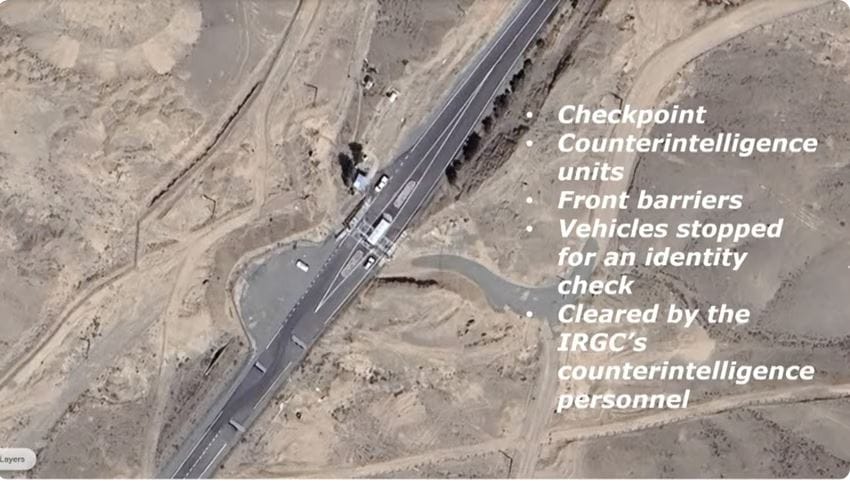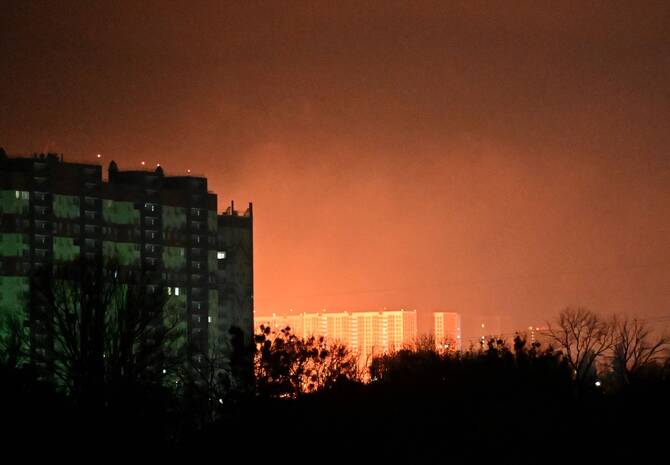SPND’s Secret Site in Ivanaki, Garmsar, Involved in the Development of Nuclear Weapons

The enclosed information has been obtained by the Defense and Strategic Research Committee of the National Council of Resistance of Iran, based on reports by the network inside Iran of the People’s Mojahedin Organization of Iran (PMOI/MEK).
Executive Summary and Key Points:
• Since 2009, SPND (Organization of Defensive Innovation and Research) has initiated a new secret project to develop a boosted nuclear weapon. According to this plan, the regime seeks to boost nuclear warheads to be mounted on ballistic missiles with a range of over 3,000 kilometers. To this end, the regime has declared Semnan Province a military zone and established facilities related to this project within the province.
• As per this plan, SPND is pursuing the extraction and utilization of tritium in the weapon's construction. The incorporation of tritium increases the nuclear weapons’ yield (especially in implosion-type devices) and also enables the potential production of hydrogen bombs.
• To achieve this, since 2013, SPND has been recruiting and transferring experts in this field from the Atomic Energy Organization of Iran’s fusion division to SPND.
• One of SPND’s projects for implementing this plan involves establishing a new secret site known internally within the regime as the “Rangin Kaman (Rainbow) Site.” Spanning an area of nearly 2500 acres in the Ivanaki (Eyvanekey) region, the facility is dedicated to the construction of various nuclear weapon components. Construction of this site began in 2009 and became operational around 2013.
• Publicly, the site operates under the guise of a chemical production facility for the oil and petrochemical industries, under the name of Diba Energy Sina Company.
• The establishment of this site is part of SPND’s broader effort to produce nuclear-armed missiles, masked as a satellite launch vehicle program. This project has been underway since 2009, parallel with the reorganization of this body within the Ministry of Defense. Five front companies were established to advance the project. Diba Energy Sina is one such company created for this purpose.
• The parent holding company for these firms is Pishtazan-e Towsee-ye San'ati-ye Arya Razi (Pioneers of Arya Razi Industrial Development), chaired by IRGC Brigadier General Naser Maleki, who at the time was the deputy of the Ministry of Defense's Aerospace Organization. In 2007, Naser Maleki was included in the UN Security Council Resolution 1747 sanctions list for being “involved in nuclear or ballistic missile activities.”
• To provide aerial protection for the project, the IRGC Aerospace Force has deployed a long-range Ghadir radar system and a missile defense unit near the site. This demonstrates the strategic importance and sensitivity of the location for the regime.
Report Details
SPND’s Secret Project for Nuclear Weapon Production
After the Amad Plan of the SPND organization—aimed at building five nuclear warheads to be mounted on Shahab-3 missiles—was halted in 2003, SPND launched a new, extensive, and classified nuclear weapons development project in 2009. According to this plan, SPND has been simultaneously working on increasing the yield of nuclear weapons and the range of ballistic missiles.
To advance this new project, and considering that some of the sites associated with the Amad Plan located in eastern Tehran Province had been exposed, the regime established a new network of sites in Semnan Province, which borders Tehran Province.
During Mahmoud Ahmadinejad’s presidency, the regime declared Semnan a military province and proceeded to develop numerous new facilities there.
The four new sites established in Semnan Province after 2009 (became operational in 2013) include:
• Ivanaki (Eyvanekey) Site
• Garmsar Radar Site
• Shahroud Missile Site
• (Expansion of the) Semnan Missile Site
Simultaneously with the establishment of the sites above-mentioned, the regime registered five front companies to advance this project.
SPND’s plan for Increasing Nuclear Weapon Power
A part of this project is aimed at enhancing the nuclear weapon capability of the regime in comparison to the nuclear weapons in the Amad Plan.
Since 2013, the SPND Organization has been recruiting and employing nuclear fusion and tritium specialists. To this end, some experts were transferred from the Nuclear Fusion Division of the Atomic Energy Organization of Iran to the SPND Organization, which was carried out with maximum secrecy.
One of these specialists, named Dr. Ebrahim Haji Ebrahimi, studied nuclear science at Amir Kabir University under the supervision of Reza Amrollahi (former head of the Atomic Energy Organization of Iran). He completed his thesis in 2011. From 2009 to 2013, he was employed at the Atomic Energy Organization. In 2013, he was transferred to the SPND Organization and completed his PhD in 2020 at the University of Mazandaran.
Another specialist, named Hadi Zaker Khatir, is an assistant professor at Malek Ashtar University of Technology, affiliated with the Ministry of Defense. According to instructions sent by the SPND Organization to universities and experts in these fields, they were requested not to publish any articles related to nuclear fusion and tritium on the internet and to remove any previously published articles.
In September 2005, the Iranian Resistance revealed that the regime had illegally purchased tritium from South Korea. In 2008, the German government prevented the transfer of a shipment of tritium gas to Iran.
Five Front Companies to Advance SPND's New Project (Missiles with Nuclear Warheads)
Since 2009, the regime has begun implementing a new plan to mount nuclear weapons on ballistic missiles. To this end, and simultaneously with the reorganization of the nuclear weapons development body known as the SPND Organization in February 2011, the regime's Ministry of Defense established five front companies to advance this plan.
The parent company of this network is named "Pishtazan-e Tose'e San'ati Aria Razi." The regime has introduced this network as being involved in the oil and petrochemical industries. One description of the company reads:
"Pishtazan-e Tose'e San'ati Aria Razi (Petsar) was established with the objective of operating in the chemical, oil, gas, petrochemical, power plant, renewable energy, and automobile industries, and has entered Iran's industrial sector...
Petsar is the holding company for four large industrial manufacturing companies:
• Pishtazan San’at Shams Omid Company
• Sazandegan Niroozay-e Afagh (SANA)
• Fanavar Andishan Pasargad Aria (FAPA)
• Diba Energy Sina Company
A review of the current and initial board members of the parent company clearly reveals its true objectives and the regime’s deception.
The chairman of the board at the time of its establishment was IRGC Brigadier General Naser Maleki, head of the Hemmat missile industry group and later Deputy Minister of Defense for Aerospace Industries. The Hemmat missile group is the main producer of the Shahab-3 missile, capable of carrying a nuclear warhead. Naser Maleki and the Hemmat group were placed under UN Security Council Resolution 1747 sanctions on March 24, 2007, for being “involved in nuclear or ballistic missile activities.”
Its current chairman of the board is Arman Azarli, who graduated in 1999 with a degree in nuclear engineering.
Original board members include:
- Seyed Mirahad Noshin, currently the head of the Ministry of Defense’s Institute for Training and Defense Research.
- Seyed Mehdi Hosseini Moones, currently the space spokesman for the Ministry of Defense and recently gave interviews about the development of the new intercontinental missiles “Sareer” and “Soroush.”
- Safdar Ali Asadi, currently the deputy of Azarab Company, which in the past produced two high explosive chambers for testing nuclear detonators under the cover of nanodiamond production.
- Alireza Moniri Abyaneh, a former manager at the Aerospace Organization, is currently the head of the Makran Petrochemical Group, which controls one-third of Iran's entire petrochemical industry.
Diba Energy Sina Company
One of the subsidiaries of the above-mentioned companies is Diba Energy Sina, which was established on June 25, 2011.
According to its initial registration, the company's purpose was “research, production, and development of technical knowledge related to the recovery of various raw, intermediate, and final materials in the fields of paint, polymer, chemical, petrochemical, cellulose, mineral industries, and thermal insulation paints.”
On one of the regime’s websites, the company’s products were described as including the production of various chemical solvents, such as ethylamine.
The company has an office at the intersection of Babaei Highway and Telou Road in eastern Tehran and a large site in the Ivanaki area in southeastern Tehran.
Currently, some board members include CEO Mahmoud Sanayei Zadeh and board member Javad Mirzaei, both of whom are chemistry experts. From 2014 to 2019, these two conducted several joint studies on the separation and extraction of chemical substances, which coincided with their involvement in Diba Energy Sina.
Location of the Ivanaki Site (Diba Energy Sina Company)
Since around 2009, the SPND Organization has undertaken the construction of its largest covert site to focus on its nuclear weapons activities. This facility, known as the “Ranginkaman Site,” is located in the Ivanaki region, southeast of Tehran. The site was named “Ranginkaman” (Rainbow) due to its proximity to a mountain range of the same name to its north. The site spans an area of 1,000 hectares (nearly 2,500 acres). Its construction took approximately five years.
IRGC Brigadier General Mostafa Siri, the head of the SPND Organization’s counterintelligence unit, is in charge of securing the site and overseeing its protection.
The site is located along the Tehran–Semnan Imam Reza Highway, past the town of Ivanaki (which lies 55 kilometers from Tehran). About 5 kilometers beyond the town, a paved military road branches off north from the main road and continues for roughly 10 kilometers, leading to a military checkpoint at the site entrance (Appendix 1).
The entire road is under military control, and local residents are prohibited from entering it. The land north of the road, stretching toward the mountainous region, is owned by the Ministry of Defense. The site is presented to locals as an IRGC missile base.
It is situated in a valley to the east of Mount Kalraz, which stands 2,231 meters high. The broader region is known as Kuh-e Sefid (White Mountain). To prevent local residents from inadvertently approaching the site, the Kuh-e Sefid region has been declared a no-hunting zone and is tightly monitored by the IRGC.
Site Facilities
The site is located inside the mountain and consists of three independent factory-like facilities, a headquarters, and a checkpoint at the entrance.
Two of these facilities, with similar structures, are located in the northern part of the site. Each contains eight or nine independent hangars (Appendixes 2 and 3).
The regime falsely introduced the site as a paint factory to some local officials who visited it during its construction to address administrative matters. Among locals, however, the site is known as a missile base. The unusual level of security around the facility made the regime’s deception apparent to personnel from other agencies.
Construction Supervised by Mohsen Fakhrizadeh Mahabadi
Mohsen Fakhrizadeh Mahabadi, who led the nuclear weapons development effort within the SPND Organization, supervised the design and construction of the Ivanaki site from the outset. Construction began around 2008–2009 to consolidate and expand SPND’s nuclear projects at a single, covert, centralized location.
Notably, Fakhrizadeh’s personal residence was in the Ab Sard township, located close to Ivanaki. He had direct access to the site via a road outside Tehran. Mohsen Fakhrizadeh Mahabadi was assassinated near Ab Sard in November 2020.
Special Security at the Ivanaki Site
The IRGC heavily guards the site. The surrounding area is fenced off and monitored by surveillance cameras, and local residents are forbidden from accessing it.
According to reports in 2013, the individual responsible for the site's security and its coordination with local authorities was known as Haj Hosseini.
Construction History and Internal Sections of the Ivanaki Site
Construction of the site began in 2009 by the IRGC. Around 2013, a dedicated paved road with strong infrastructure and multiple concrete bridges was built to support the facility. The site includes the following sections:
First Section of the Site
This part is located at the northernmost area of the site, approximately 5 kilometers from the entrance. Construction began in 2009 with excavation work, and the facilities were completed by 2013. A significant portion of this section is underground. The surface area is approximately 250 meters by 500 meters and contains a large facility complex with about nine independent buildings (Appendix 3).
Second Section of the Site
This section was built in 2009, about 1.5 kilometers south of the first section (on the west side of the road). The land measures roughly 250 meters by 500 meters and includes a complex of about eight buildings, one of which is a hangar measuring 120 meters in length and 30 meters in width (Appendix 4). The notable distance between the two sections indicates consideration for safety and containment of potential hazards. The facilities in this section are similar to those in the first, with minor variations in building layout. Aerial images from 2013 show extensive excavation around this area, corresponding to the development of underground structures.
Third Section of the Site
This section, constructed in 2009 near the second section on the eastern side of the road, covers an area of 150 by 300 meters. It includes a double-span hangar with a blue roof, measuring 50 meters in length and 30 meters in width (Appendix 5).
Site Entrance Area
At the site entrance, the checkpoint and the counterintelligence unit are stationed. Vehicles stop at the site’s parking area after passing through the front barriers, and only after identity documents are inspected and cleared by the IRGC’s counterintelligence personnel are individuals granted access (Appendix 6).
Qadir Long-Range Radar Site in Southern Garmsar
The IRGC Aerospace Force has established a radar site known as “Qadir” near the village of Nouraldinabad, located in the southern part of Garmsar County. Additionally, an air defense missile site is located approximately 10 kilometers south of Nouraldinabad village. The aerial distance between this radar site and the Diba Energy site is 28 kilometers. The radar site was established in 2013, concurrently with the activation of the Ivanaki (Diba Energy) site.
The deployment of a long-range radar and missile defense system near the Ivanaki site underscores the strategic importance and sensitivity of the facility for the regime (Appendix 7).
Conclusion:
Our revelation today once again demonstrates that the Iranian regime's nuclear program is entirely aimed at acquiring nuclear weapons. It also proves that all of Iran's nuclear sites must be shut down. No enrichment capability must be allowed. The missile program of the regime is part and parcel of its acquiring nuclear warheads. The role that the IAEA should play is to verify the closure of all the sites.
The regime's goal has never been anything but building a nuclear bomb. Over the past three decades, all of the regime's nuclear activities have been first exposed, much of it by the NCRI and its network inside Iran, the People’s Mojahedin Organization of Iran (PMOI/MEK), and then the regime has been forced to acknowledge them.
Obtaining nuclear weapons is part of the regime's survival strategy and has absolutely no foundation in the production of civilian nuclear energy. While two trillion dollars have been spent on this program over the past three decades, there has been no significant investment in the oil and gas industry. Today, a significant portion of the gasoline and natural gas consumed within Iran is imported from abroad.
The mullahs' regime is in its weakest position and faces an explosive society. Since Pezeshkian took office as the regime’s new president in August, more than 1,200 prisoners, including political prisoners, have been executed, and currently, dozens of political prisoners are at risk of execution.
The regime's policy remains one of dragging and delaying to run the clock while dashing towards building nuclear weapons. Now is the time to end this cycle.
Now is the time to prohibit any enrichment and to completely close the entire nuclear apparatus of the regime. The UN snapback mechanism to reimpose all UN Security Council sanctions must be activated before it expires in a few months.
This regime's threat to global peace and stability is not limited to its nuclear program. The genocide inside Iran, as confirmed by the UN Special Rapporteur, and the export of terrorism and warmongering necessitate a decisive policy towards it.
We have always emphasized that the solution to the Iranian regime's nuclear threat and its threat to global peace and security is its overthrow by the Iranian people and the Iranian organized resistance.
There is no need for foreign boots on the ground or the appropriation of money. The international community should recognize the right of the Iranian people to confront the Revolutionary Guards and end the rule of the clerics.





